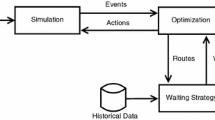Abstract
In dynamic pickup and delivery problems with time windows (PDPTWs), potentially urgent request information is released over time. This gradual data availability means the decision-making process must be continuously repeated. These decisions are therefore likely to deteriorate in quality as new information becomes available. It is still believed that the state of the art for this problem remains far from reaching maturity due to the distinct absence of algorithms and tools for obtaining high-quality solutions within reasonable computational runtimes. This paper proposes a periodic approach to the dynamic PDPTW based on buffering, more specifically a two-step scheduling heuristic which consists of the cheapest insertion followed by a local search. The heuristic’s performance is assessed by comparing its results against those obtained by a mixed integer linear programming model which operates under the assumption that all information is available in advance. Results illustrate how the performance is impacted by urgency levels, the degree of dynamism associated with request arrivals and re-optimization frequency. The findings indicate that increases in dynamism improve solution quality, whereas increases in urgency have the opposite effect. In addition, the proposed approach’s performance is only slightly affected by re-optimization frequency when changing these two characteristics.













Similar content being viewed by others
References
Angelelli, E., Bianchessi, N., Mansini, R., & Speranza, M. G. (2009). Short term strategies for a dynamic multi-period routing problem. Transportation Research Part C: Emerging Technologies, 17(2), 106–119.
Attanasio, A., Bregman, J., Ghiani, G., & Manni, E. (2007). Real-time fleet management at ecourier ltd. Dynamic Fleet Management (pp. 219–238). Berlin: Springer.
Attanasio, A., Cordeau, J.-F., Ghiani, G., & Laporte, G. (2004). Parallel tabu search heuristics for the dynamic multi-vehicle dial-a-ride problem. Parallel Computing, 30(3), 377–387.
Ausiello, G., Crescenzi, P., Gambosi, G., Kann, V., Marchetti-Spaccamela, A., & Protasi, M. (2012). Complexity and approximation: Combinatorial optimization problems and their approximability properties. Berlin: Springer.
Barceló, J., Grzybowska, H., & Pardo, S. (2007). Vehicle routing and scheduling models, simulation and city logistics. Dynamic Fleet Management (pp. 163–195). Berlin: Springer.
Beaudry, A., Laporte, G., Melo, T., & Nickel, S. (2010). Dynamic transportation of patients in hospitals. OR Spectrum, 32(1), 77–107.
Bent, R., & Van Hentenryck, P. (2006). A two-stage hybrid algorithm for pickup and delivery vehicle routing problems with time windows. Computers & Operations Research, 33(4), 875–893.
Berbeglia, G., Cordeau, J.-F., & Laporte, G. (2010). Dynamic pickup and delivery problems. European Journal of Operational Research, 202(1), 8–15.
Berbeglia, G., Cordeau, J.-F., & Laporte, G. (2012). A hybrid tabu search and constraint programming algorithm for the dynamic dial-a-ride problem. INFORMS Journal on Computing, 24(3), 343–355.
Berbeglia, G., Pesant, G., & Rousseau, L.-M. (2011). Checking the feasibility of dial-a-ride instances using constraint programming. Transportation Science, 45(3), 399–412.
Bock, S. (2010). Real-time control of freight forwarder transportation networks by integrating multimodal transport chains. European Journal of Operational Research, 200(3), 733–746.
Borodin, A., & El-Yaniv, R. (2005). Online computation and competitive analysis. Cambridge: Cambridge University Press.
Chang, M.-S., Chen, S.-R., & Hsueh, C.-F. (2003). Real-time vehicle routing problem with time windows and simultaneous delivery/pickup demands. Journal of the Eastern Asia Society for Transportation Studies, 5, 2273–2286.
Cheung, B. K.-S., Choy, K., Li, C.-L., Shi, W., & Tang, J. (2008). Dynamic routing model and solution methods for fleet management with mobile technologies. International Journal of Production Economics, 113(2), 694–705.
Christiaens, J., & Vanden Berghe, G. (2020). Slack induction by string removals for vehicle routing problems. Transportation Science (to appear) available as TR, KU Leuven.
Coslovich, L., Pesenti, R., & Ukovich, W. (2006). A two-phase insertion technique of unexpected customers for a dynamic dial-a-ride problem. European Journal of Operational Research, 175(3), 1605–1615.
Curtois, T., Landa-Silva, D., Qu, Y., & Laesanklang, W. (2018). Large neighbourhood search with adaptive guided ejection search for the pickup and delivery problem with time windows. EURO Journal on Transportation and Logistics, 7(2), 151–192.
Dunke, F., & Nickel, S. (2016). A general modeling approach to online optimization with lookahead. Omega, 63, 134–153.
Fabri, A., & Recht, P. (2006). On dynamic pickup and delivery vehicle routing with several time windows and waiting times. Transportation Research Part B: Methodological, 40(4), 335–350.
Ferrucci, F., & Bock, S. (2014). Real-time control of express pickup and delivery processes in a dynamic environment. Transportation Research Part B: Methodological, 63, 1–14.
Fiegl, C., & Pontow, C. (2009). Online scheduling of pick-up and delivery tasks in hospitals. Journal of Biomedical Informatics, 42(4), 624–632.
Fleischmann, B., Gnutzmann, S., & Sandvoß, E. (2004). Dynamic vehicle routing based on online traffic information. Transportation Science, 38(4), 420–433.
Gan, Z., Tao, L., & Ying, Q. (2013). Automated guided vehicles dynamic scheduling based on annealing genetic algorithm. TELKOMNIKA Indonesian Journal of Electrical Engineering, 11(5), 2508–2515.
Gendreau, M., Guertin, F., Potvin, J.-Y., & Séguin, R. (2006). Neighborhood search heuristics for a dynamic vehicle dispatching problem with pick-ups and deliveries. Transportation Research Part C: Emerging Technologies, 14(3), 157–174.
Ghiani, G., Manni, E., & Thomas, B. W. (2012). A comparison of anticipatory algorithms for the dynamic and stochastic traveling salesman problem. Transportation Science, 46(3), 374–387.
Goel, A., & Gruhn, V. (2008). A general vehicle routing problem. European Journal of Operational Research, 191(3), 650–660.
Gomes, R., de Sousa, J. P., & Dias, T. G. (2014). A grasp-based approach for demand responsive transportation. International Journal of Transportation, 2(1), 21–32.
Grötschel, M., Krumke, S. O., Rambau, J., Winter, T., & Zimmermann, U. T. (2001). Combinatorial online optimization in real time. Berlin: Springer.
Held, M., & Karp, R. M. (1962). A dynamic programming approach to sequencing problems. Journal of the Society for Industrial and Applied mathematics, 10(1), 196–210.
Karami, F., Vancroonenburg, W., and Vanden Berghe, G. (2018). A dynamic scheduling approach to internal hospital logistics. In The Second International Workshop on Dynamic Scheduling Problems, Poznań, Poland, June 26–28 (pp. 57–62).
Kergosien, Y., Lente, C., Piton, D., & Billaut, J.-C. (2011). A tabu search heuristic for the dynamic transportation of patients between care units. European Journal of Operational Research, 214(2), 442–452.
Kilby, P., Prosser, P., & Shaw, P. (1998). Dynamic VRPs: A study of scenarios. University of Strathclyde Technical Report, 1–11.
Kouki, Z., Chaar, B. F., and Ksouri, M. (2009). Extended CNP framework for the dynamic pickup and delivery problem solving. In IFIP International Conference on Artificial Intelligence Applications and Innovations (pp. 61–71). Berlin: Springer.
Larsen, A., Madsen, O. B., & Solomon, M. (2002). Partially dynamic vehicle routing-models and algorithms. Journal of the Operational Research Society, 53(6), 637–646.
Li, J.-Q., Mirchandani, P. B., & Borenstein, D. (2009). Real-time vehicle rerouting problems with time windows. European Journal of Operational Research, 194(3), 711–727.
Lim, A., & Zhang, X. (2007). A two-stage heuristic with ejection pools and generalized ejection chains for the vehicle routing problem with time windows. INFORMS Journal on Computing, 19(3), 443–457.
Lund, K., Madsen, O. B., and Rygaard, J. M. (1996). Vehicle routing problems with varying degrees of dynamism (technical report). Lyngby, Denmark: IMM, The Department of Mathematical Modelling, Technical University of Denmark.
Máhr, T., Srour, J., de Weerdt, M., & Zuidwijk, R. (2010). Can agents measure up? A comparative study of an agent-based and on-line optimization approach for a drayage problem with uncertainty. Transportation Research Part C: Emerging Technologies, 18(1), 99–119.
Mitrović-Minić, S., Krishnamurti, R., & Laporte, G. (2004). Double-horizon based heuristics for the dynamic pickup and delivery problem with time windows. Transportation Research Part B: Methodological, 38(8), 669–685.
Mitrović-Minić, S., & Laporte, G. (2004). Waiting strategies for the dynamic pickup and delivery problem with time windows. Transportation Research Part B: Methodological, 38(7), 635–655.
Nagata, Y. and Kobayashi, S. (2010). A memetic algorithm for the pickup and delivery problem with time windows using selective route exchange crossover. In International Conference on Parallel Problem Solving from Nature (pp. 536–545). Berlin: Springer.
Pisinger, D., & Røpke, S. (2007). A general heuristic for vehicle routing problems. Computers & Operations Research, 34(8), 2403–2435.
Powell, W. B., Towns, M. T., & Marar, A. (2000). On the value of optimal myopic solutions for dynamic routing and scheduling problems in the presence of user noncompliance. Transportation Science, 34(1), 67–85.
Psaraftis, H. N. (1980). A dynamic programming solution to the single vehicle many-to-many immediate request dial-a-ride problem. Transportation Science, 14(2), 130–154.
Psaraftis, H. N., Wen, M., & Kontovas, C. A. (2016). Dynamic vehicle routing problems: Three decades and counting. Networks, 67(1), 3–31.
Pureza, V., & Laporte, G. (2008). Waiting and buffering strategies for the dynamic pickup and delivery problem with time windows. INFOR: Information Systems and Operational Research, 46(3), 165–175.
Renaud, J., Boctor, F. F., & Ouenniche, J. (2000). A heuristic for the pickup and delivery traveling salesman problem. Computers & Operations Research, 27(9), 905–916.
Savelsbergh, M. W., & Sol, M. (1995). The general pickup and delivery problem. Transportation Science, 29(1), 17–29.
Schyns, M. (2015). An ant colony system for responsive dynamic vehicle routing. European Journal of Operational Research, 245(3), 704–718.
Secomandi, N., & Margot, F. (2009). Reoptimization approaches for the vehicle-routing problem with stochastic demands. Operations Research, 57(1), 214–230.
Speranza, M. G. (2018). Trends in transportation and logistics. European Journal of Operational Research, 264(3), 830–836.
Swihart, M. R., & Papastavrou, J. D. (1999). A stochastic and dynamic model for the single-vehicle pick-up and delivery problem. European Journal of Operational Research, 114(3), 447–464.
Ulmer, M. W., Mattfeld, D. C., & Köster, F. (2017). Budgeting time for dynamic vehicle routing with stochastic customer requests. Transportation Science, 52(1), 20–37.
van Lon, R. R., Ferrante, E., Turgut, A. E., Wenseleers, T., Vanden Berghe, G., & Holvoet, T. (2016). Measures of dynamism and urgency in logistics. European Journal of Operational Research, 253(3), 614–624.
Vancroonenburg, W., Esprit, E., Smet, P., & Vanden Berghe, G. (2016). Optimizing internal logistic flows in hospitals by dynamic pick-up and delivery models. In Proceedings of the 11th international conference on the practice and theory of automated timetabling, Udine, Italy, 23–26 August (pp. 371–383).
Yang, J., Jaillet, P., & Mahmassani, H. (2004). Real-time multivehicle truckload pickup and delivery problems. Transportation Science, 38(2), 135–148.
Acknowledgements
Wim Vancroonenburg is a postdoctoral research fellow at Research Foundation Flanders - FWO Vlaanderen. This research is funded by FWO as part of ORDinL (Operational Research and Data science in Logistics) project under the Strategic Basic Research (SBO) programme. Editorial consultation is provided by Luke Connolly (KU Leuven).
Author information
Authors and Affiliations
Corresponding author
Additional information
Publisher's Note
Springer Nature remains neutral with regard to jurisdictional claims in published maps and institutional affiliations.
Appendix: Terminology
Appendix: Terminology
List of notations
\(\theta _i\) | Input element i | S | Set of feasible solutions |
ET | Execution time, re-optimization step length | \(\Theta \) | Set of the PDPTW’s instances |
\(p_i\) | A task i’s service time | \(\theta \) | The PDPTW instance |
\([st_i,dt_i)\) | Time window of task i | R | Set of all requests |
UW | Urgency window | \(T^p\) | Set of all pickup tasks |
\([st_{k},dt_{k})\) | Vehicle k ’s availability time window | \(T^d\) | Set of all delivery tasks |
\(\tau \) | Scheduling horizon length | T | Set of all tasks (\(T=T^p \cup T^d\)) |
V | Fleet of vehicles | V | Set of all vehicles |
\(\varepsilon \) | All request arrival events | VK | Set of all undispatched vehicles |
\(Ct_i\) | Task i’s completion time | RL | Set of all eligible requests |
\(ot_{k}\) | Vehicle k’s overtime | \(UR_t\) | Set of unprocessed requests at time t |
\(d_{ij}\) | Travel time from location i to j | \(CP_t\), | Set of currently processing requests at time t |
\(l_{i}\) | Tardiness of task i | \(CE_t\) | Set of currently executing requests at time t |
\(ot_{k}\) | Overtime of vehicle k. | \(FR_t\) | Set of finished requests |
Rights and permissions
About this article
Cite this article
Karami, F., Vancroonenburg, W. & Vanden Berghe, G. A periodic optimization approach to dynamic pickup and delivery problems with time windows. J Sched 23, 711–731 (2020). https://doi.org/10.1007/s10951-020-00650-x
Published:
Issue Date:
DOI: https://doi.org/10.1007/s10951-020-00650-x




